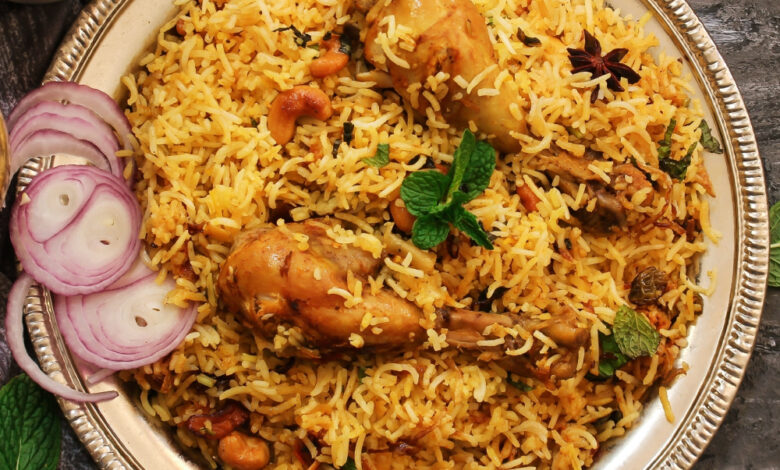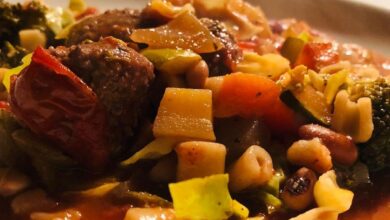
Hyderabadi Biryani Recipe Introduction:
Hyderabadi Biryani is a celebrated dish from South India, known for its rich flavors and aromatic spices. Originating from the city of Hyderabad, this biryani is a perfect blend of Mughlai and Persian culinary traditions with a South Indian twist. The dish is characterized by its use of basmati rice, tender marinated meat (usually chicken or mutton), and a variety of spices that create a complex and aromatic flavor profile.
Hyderabadi Biryani is a beloved and iconic dish renowned for its intricate preparation and exceptional taste. It’s a dish that embodies the essence of Hyderabad’s rich culinary heritage, combining the legacy of Mughal influences with local spices and cooking methods.

Hyderabadi Biryani Recipe Ingredients:
Hyderabadi Biryani Ingredients
For the Meat Marinade:
- Meat: 500 grams chicken (bone-in preferred) or mutton (bone-in or boneless)
- Plain Yogurt: 1 cup
- Ginger-Garlic Paste: 2 tablespoons
- Red Chili Powder: 1 tablespoon
- Turmeric Powder: 1 teaspoon
- Garam Masala: 1 teaspoon
- Salt: to taste
- Fresh Coriander Leaves: 2 tablespoons, chopped
- Fresh Mint Leaves: 2 tablespoons, chopped
For the Rice:
- Basmati Rice: 2 cups
- Water: 4 cups (for cooking rice)
- Caraway Seeds (Shah Jeera): 1 teaspoon
- Salt: to taste
For the Spices and Aroma:
- Cloves: 4-5
- Green Cardamom Pods: 2-3
- Bay Leaf: 1
- Cinnamon Stick: 1-inch piece
- Cumin Seeds: 1 teaspoon
For Layering and Garnishing:
- Fried Onions: 2 large onions, thinly sliced and fried until golden brown
- Ghee (Clarified Butter): 2 tablespoons (or oil)
- Saffron Strands: 1/2 teaspoon, soaked in 2 tablespoons warm milk
- Fresh Coriander Leaves: a handful, chopped (for layering)
- Fresh Mint Leaves: a handful, chopped (for layering)
For Cooking the Meat:
- Ghee (Clarified Butter) or Oil: 2 tablespoons
Optional:
- Boiled Eggs: 2-4 (for serving or layering)
- Raita: Yogurt-based side dish to serve with biryani
These ingredients come together to create the rich, aromatic layers of Hyderabadi Biryani. The marination process infuses the meat with spices and yogurt, while the layering and slow-cooking technique help in melding the flavors perfectly. Enjoy your cooking!
Hyderabadi Biryani Recipe Ingredient Tips:
When preparing Hyderabadi Biryani, the quality and handling of ingredients play a crucial role in achieving the best flavor and texture. Here are some tips for each ingredient to help you create an exceptional dish:
Ingredient Tips for Hyderabadi Biryani
1. Meat:
- Choice: Opt for bone-in chicken or mutton for more flavor and tenderness. If using boneless meat, ensure it’s cut into uniform pieces for even cooking.
- Marination: Marinate the meat for at least 2 hours, or overnight if possible. This helps in tenderizing the meat and allows it to absorb the flavors.
2. Basmati Rice:
- Quality: Use high-quality basmati rice for the best aroma and texture. Look for aged basmati rice if possible, as it tends to be more fragrant and less sticky.
- Soaking: Soak the rice for 30 minutes before cooking to ensure it cooks evenly and remains fluffy. Rinse the rice until the water runs clear to remove excess starch.
3. Plain Yogurt:
- Consistency: Use thick, full-fat yogurt for a creamy marinade. Avoid using watery yogurt, as it can dilute the flavors.
- Homemade vs. Store-bought: Homemade yogurt can be more flavorful, but store-bought works well too. Just ensure it’s fresh and not too tangy.
4. Spices:
- Freshness: Use fresh spices for the most robust flavor. Ground spices lose their potency over time, so if possible, use whole spices and grind them as needed.
- Toasting: Lightly toast whole spices like cloves, cardamom, and cumin seeds before using them to enhance their flavor.
5. Saffron:
- Quality: Use high-quality saffron threads for the best color and aroma. Be cautious of imitation saffron, which may not provide the desired flavor.
- Soaking: Soak saffron threads in warm milk for at least 10 minutes to release its color and flavor before adding it to the biryani.
6. Fried Onions:
- Homemade vs. Store-bought: Homemade fried onions provide a fresher taste and better texture compared to store-bought. Fry onions until they are golden brown and crispy.
- Storage: If using store-bought fried onions, ensure they are crispy and not stale. Stale onions can affect the texture and flavor of the biryani.
7. Fresh Herbs (Coriander and Mint):
- Quantity: Use a generous amount of fresh coriander and mint leaves for layering. They add freshness and a burst of flavor to the biryani.
- Storage: Use fresh herbs rather than dried. If you need to store them, keep them in the refrigerator in an airtight container to maintain their freshness.
8. Ghee (Clarified Butter) or Oil:
- Flavor: Ghee adds a rich, nutty flavor to the biryani. If using oil, opt for a neutral oil or a small amount of flavored oil.
- Quantity: Don’t skimp on ghee or oil as it helps in layering the biryani and adds to the richness of the dish.
9. Boiled Eggs (Optional):
- Preparation: Boil eggs until hard and peel them before adding them to the biryani. You can either layer them or serve them on the side.
10. Dum Cooking:
- Sealing: Ensure the pot is well-sealed during the dum (slow cooking) process. You can use a dough seal or a tight-fitting lid to trap the steam and flavors.
- Heat: Cook on low heat to prevent burning and to allow the flavors to meld properly.
Hyderabadi Biryani Recipe Equipment Needed:
To make Hyderabadi Biryani successfully, you’ll need a few essential pieces of equipment to manage the preparation, cooking, and serving of this flavorful dish. Here’s a list of the equipment you’ll need:
Essential Equipment for Hyderabadi Biryani
**1. Large Bowl:
- Purpose: For marinating the meat and mixing the yogurt with spices. A large, non-reactive bowl (like glass or stainless steel) works best.
**2. Heavy-Bottomed Pot or Pressure Cooker:
- Purpose: For cooking the meat. A heavy-bottomed pot is ideal for even cooking and to prevent burning. If using a pressure cooker, ensure it has enough capacity to handle the meat and avoid overfilling.
**3. Large Stockpot:
- Purpose: For boiling and partially cooking the rice. Choose a pot that can hold a good amount of water and rice without overflowing.
**4. Sieve or Colander:
- Purpose: To drain the rice after parboiling. A fine-mesh sieve or colander will help you easily separate the rice from the water.
**5. Skillet or Pan:
- Purpose: For frying onions until golden brown. A large skillet or frying pan allows you to cook the onions evenly and achieve a crispy texture.
**6. Mortar and Pestle or Spice Grinder:
- Purpose: For grinding whole spices if needed. A mortar and pestle or a spice grinder helps release the essential oils and flavors of whole spices.
**7. Measuring Cups and Spoons:
- Purpose: To measure spices, yogurt, rice, and other ingredients accurately.
**8. Wooden Spoon or Spatula:
- Purpose: For mixing and stirring the marinade, rice, and meat. A wooden spoon or spatula is gentle on cookware and helps prevent sticking.
**9. Lid for Dum Cooking:
- Purpose: For sealing the pot during the dum (slow-cooking) process. You can use a heavy lid or seal the pot with dough to trap steam and flavors.
**10. Dough (Optional, for Sealing):
- Purpose: To seal the pot during dum cooking. This helps in trapping steam and cooking the biryani evenly.
**11. Tongs or Slotted Spoon:
- Purpose: For handling the cooked rice and meat, especially when layering them in the pot.
**12. Serving Dishes:
- Purpose: For serving the biryani. A large serving dish or bowl will be needed to present the biryani elegantly.
**13. Rice Cooker (Optional):
- Purpose: For cooking the rice. If you have a rice cooker, it can make the rice preparation more convenient and ensure perfectly cooked rice.
**14. Raita Bowl:
- Purpose: For serving raita (yogurt-based side dish) alongside the biryani.
These pieces of equipment will help you manage the different steps of preparing Hyderabadi Biryani, from marinating and cooking to layering and serving. Having the right tools ensures that each component of the dish is cooked properly and combined seamlessly.
Hyderabadi Biryani Recipe Step-by-Step Instructions:
- Marinate the Meat:
- In a large bowl, mix yogurt, ginger-garlic paste, red chili powder, turmeric powder, garam masala, and salt.
- Add the meat pieces and coat them thoroughly with the marinade.
- Stir in half of the chopped coriander and mint leaves.
- Cover and refrigerate for at least 2 hours, preferably overnight.
- Prepare the Rice:
- Rinse the basmati rice under cold water until the water runs clear to remove excess starch.
- Soak the rice in water for 30 minutes, then drain.
- In a large stockpot, bring 4 cups of water to a boil. Add caraway seeds and salt.
- Add the soaked and drained rice to the boiling water.
- Cook the rice until it’s 70% cooked (parboiled). It should still be firm.
- Drain the rice and set it aside.
- Cook the Meat:
- Heat ghee or oil in a heavy-bottomed pot or pressure cooker.
- Add cloves, cardamom pods, bay leaf, cinnamon stick, and cumin seeds. Sauté until fragrant.
- Add the marinated meat and cook until it’s browned and cooked through (about 15-20 minutes). If using a pressure cooker, cook for about 10 minutes with 1 whistle.
- Layer the Biryani:
- In a heavy-bottomed pot, spread a layer of partially cooked rice.
- Add a portion of the cooked meat on top of the rice.
- Sprinkle some fried onions, chopped coriander, and mint leaves over the meat.
- Add another layer of rice over the meat and repeat the process.
- Drizzle the saffron milk over the top layer of rice.
- Garnish with additional fried onions and fresh herbs.
- Dum Cooking:
- Seal the pot with a tight-fitting lid. You can also use dough to seal the edges if desired.
- Cook on very low heat for 30-40 minutes. This allows the flavors to meld together and the rice to fully cook.
- If using a pressure cooker, ensure it is on the lowest heat setting.
- Serve:
- Gently fluff the biryani with a fork to mix the layers.
- Serve hot with raita (yogurt-based side dish), salad, and/or boiled eggs.
Additional Tips:
- Dum Cooking: The slow cooking (dum) process is crucial for integrating flavors. Make sure the heat is very low to avoid burning.
- Garnishes: Fried onions add a nice crunch and sweetness. You can make these at home or use store-bought, but homemade is often preferred for better texture and flavor.
- Raita: A cooling raita complements the spiciness of the biryani and adds freshness.
Enjoy your Hyderabadi Biryani, a dish that’s perfect for special occasions or a hearty meal with family and friends!
Hyderabadi Biryani Recipe Tips and Tricks:
Making Hyderabadi Biryani can be a rewarding experience, and a few tips and tricks can help ensure that your biryani turns out perfectly. Here are some helpful suggestions to enhance your cooking:
Hyderabadi Biryani Recipe Tips and Tricks
1. Marinating the Meat:
- Long Marination: Marinate the meat for at least 2 hours, but overnight is ideal. This allows the spices to penetrate deeply and tenderizes the meat.
- Yogurt Consistency: Use thick, full-fat yogurt for the marinade to ensure it clings well to the meat and provides a rich flavor.
2. Preparing the Rice:
- Soaking: Always soak the basmati rice for at least 30 minutes before cooking. This helps the grains to elongate and become fluffy.
- Avoid Overcooking: Parboil the rice until it’s about 70% cooked to prevent it from becoming mushy during the dum cooking process.
- Seasoning the Water: Add a generous amount of salt and caraway seeds to the water when cooking the rice for extra flavor.
3. Cooking the Meat:
- Browning: Ensure the meat is well-browned before layering with rice. This step enhances the flavor through caramelization.
- Layering: Layer the rice and meat evenly to ensure every serving gets a balanced mix of both.
4. Spices and Aromatics:
- Fresh Spices: Use fresh whole spices and grind them as needed for a more intense flavor. Store-bought ground spices can lose their potency over time.
- Toasting Spices: Lightly toast whole spices in a dry pan before using them to release their essential oils and enhance their flavor.
5. Saffron:
- Proper Soaking: Soak saffron threads in warm milk for at least 10 minutes before adding them to the biryani. This ensures the color and aroma are fully extracted.
- Quality: Use high-quality saffron for the best color and flavor. Be cautious of imitation saffron.
6. Dum Cooking (Slow Cooking):
- Seal the Pot: Seal the pot tightly to trap steam and ensure even cooking. You can use dough around the lid or a tight-fitting lid for best results.
- Low Heat: Cook on very low heat to avoid burning the bottom and to allow the flavors to meld together properly. Avoid opening the lid frequently during the cooking process.
7. Garnishing:
- Fried Onions: Homemade fried onions are preferred for their texture and flavor. Fry them until golden brown and crispy. Store-bought fried onions can be used in a pinch but may not be as fresh.
- Herbs: Use fresh coriander and mint leaves for layering and garnishing. They add a burst of fresh flavor and aroma.
8. Serving:
- Fluffing: Gently fluff the biryani with a fork before serving to mix the layers and avoid mashing the rice.
- Accompaniments: Serve with raita (yogurt-based side dish), salad, or a boiled egg for a complete meal.
9. Storage and Reheating:
- Storage: If you have leftovers, store them in an airtight container in the refrigerator. Biryani can be kept for 2-3 days.
- Reheating: Reheat gently to avoid drying out the rice. You can sprinkle a little water over the biryani before reheating to maintain moisture.
10. Additional Variations:
- Vegetable Biryani: You can substitute the meat with a mix of vegetables for a vegetarian version. Ensure the vegetables are cut into uniform pieces and cook them until tender before layering.
- Different Meats: Experiment with different types of meat, such as beef or lamb, but adjust cooking times as needed.
Serving Suggestions:
1. Raita:
- Cucumber Raita: A refreshing mix of yogurt, grated cucumber, cumin, and fresh herbs. It helps balance the spiciness of the biryani.
- Onion Raita: Yogurt mixed with thinly sliced onions, chopped coriander, and spices. Adds a tangy and cooling element.
- Boondi Raita: Yogurt mixed with crispy boondi (tiny fried chickpea flour balls), and garnished with spices.
2. Salad:
- Kachumber Salad: A fresh salad made with diced cucumber, tomatoes, onions, and cilantro, dressed with lemon juice and spices.
- Carrot and Cabbage Salad: A crunchy, tangy salad with shredded carrots and cabbage, often seasoned with lemon juice and chaat masala.
3. Pickles:
- Mango Pickle: Spicy and tangy mango pickle adds a zesty flavor that pairs well with the biryani.
- Lemon Pickle: Adds a tart and spicy kick to complement the rich flavors of the biryani.
4. Side Dishes:
- Boiled Eggs: Serve boiled eggs on the side or layer them in the biryani for added protein and flavor.
- Papadums: Crispy and crunchy, they provide a nice texture contrast to the soft biryani.
- Raita: Various types of raita (yogurt-based condiments) can enhance the overall dining experience.
5. Sauces and Chutneys:
- Mint Chutney: A spicy and fresh chutney made from mint, cilantro, green chilies, and lemon juice. It pairs well with the biryani.
- Tamarind Chutney: Adds a sweet and tangy flavor that can complement the spices in the biryani.
6. Bread:
- Naan: Soft, pillowy naan can be used to scoop up the biryani and adds a nice textural contrast.
- Paratha: Flaky, buttery parathas also pair well with biryani, providing an additional layer of flavor.
7. Drinks:
- Lassi: A cooling yogurt-based drink, either sweet or salty, helps balance the spiciness of the biryani.
- Chai: A spiced tea can be a comforting end to a hearty meal.
8. Garnishes:
- Fresh Coriander and Mint: Garnish with fresh chopped coriander and mint leaves for added color and freshness.
- Fried Onions: Extra fried onions on top can enhance the texture and flavor of the biryani.
Plating and Presentation:
- Serve in a Large Dish: For a family-style meal, serve the biryani in a large, attractive serving dish.
- Layering: When serving, gently mix the layers of rice and meat to ensure even distribution.
- Accompaniments on the Side: Arrange raita, salad, and pickles on the side for guests to help themselves.
These serving suggestions can help you create a well-rounded meal that complements the rich and aromatic Hyderabadi Biryani, making your dining experience enjoyable and satisfying.
FAQs:
1. What is the best meat to use for Hyderabadi Biryani?
Answer: Traditionally, Hyderabadi Biryani is made with mutton (lamb) or chicken. Bone-in pieces are preferred for their flavor and tenderness. Mutton is often used for its richer taste, while chicken is a quicker and lighter option. You can use boneless chicken or lamb if you prefer, but bone-in pieces add more depth to the flavor.
2. How long should I marinate the meat?
Answer: For the best results, marinate the meat for at least 2 hours, though overnight is ideal. This allows the spices and yogurt to tenderize the meat and infuse it with flavor.
3. Can I use pre-cooked or leftover rice for biryani?
Answer: It’s best to use freshly cooked, parboiled rice for biryani. Pre-cooked or leftover rice can become mushy when layered and cooked further. If using leftover rice, ensure it is not too dry, and adjust the cooking time to avoid overcooking.
4. How do I achieve fluffy rice in biryani?
Answer: To achieve fluffy rice, rinse the basmati rice thoroughly until the water runs clear to remove excess starch. Soak the rice for at least 30 minutes before cooking. Cook the rice until it is about 70% done (parboiled) before layering it with the meat. Avoid overcooking the rice to keep it from becoming mushy during the final cooking stage.
5. Can I make Hyderabadi Biryani in a pressure cooker?
Answer: Yes, you can make Hyderabadi Biryani in a pressure cooker, but it requires careful timing. Brown the meat and add the spices as you would in a pot, then layer the rice and meat and cook on low heat for about 10 minutes with 1 whistle. Ensure you do not overcook the biryani to avoid mushy rice.





